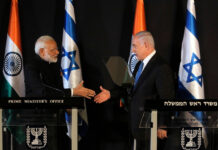While the traditional world remains focused on the military instability of the Middle Eastern scene, another area will most probably shift into world attention by 2011- the Far East, or more specifically – China and the Indian subcontinent. Whatever the case may be, the image of Barack Hussein Obama’s global strategy is already waning dangerously among the regional bystanders, watching every move made by Washington with growing concern or malicious glee, depending on which party they see themselves adhering to.
So far the pell-mell troop exodus from Iraq was a lucky strike- by-passing the Basrah bottleneck undisturbed- itself a logistical masterpiece, reminds one of the 1940 Dunkirk miracle. But the prospect of a massive withdrawal, from the vulnerable Afghanistan battle zone, might prove far from easy. With nearly all US bases in Central Asia now gone and Pakistan supply routes becoming totally unreliable, it will need more than a logistical marvel to get the troops out of harm’s way and fully intact to fight another contingency challenge. These days, Afghanistan already presents a logistical nightmare for the Americans, its landlocked country with 80 percent of American supplies having to go in overland in trucks. And the need for urgent supplies is tremendous, with over 100,000 troops consuming a vast amount of fuel and ammunition and other military supplies each single day.
South Asia is still a morass in 2010 and 2011 does not look any better. Though the U.S. troop surge seems to have given Obama some breathing time in Afghanistan, it will be short-lived respite. Afghanistan will produce bigger and bigger domestic headlines, but not much will actually change until the United States is forced to reach a decision point. According to President Obama’s plan, that’s 2011 at the earliest, but all his options seem bleak.
2011 Flashpoints: Asia features include the following topics:
















